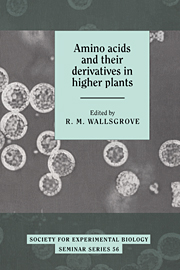Book contents
- Frontmatter
- Contents
- List of contributors
- Preface
- Glutamine synthetase in higher plants: molecular biology meets plant physiology
- Interactions of nitrogen and carbon metabolism: implications of PEP carboxylase and isocitrate dehydrogenase
- The genetics of aspartate derived amino acids in higher plants
- Oxidation of 1-aminocyclopropane-1-carboxylic acid (ACC) in the generation of ethylene by plants
- Regulation of carbon flow through the branched chain amino acid biosynthetic pathway
- Amino acid metabolism and protein deposition in the endosperm of wheat: synthesis of proline via ornithine
- The glycine decarboxylase complex in higher plant mitochondria: structure, function and biogenesis
- Glycine and serine synthesis in non-photosynthetic tissues
- Biogenesis of N-heterocydic amino acids by plants: mechanisms of biological significance
- Toxicity of non-protein amino acids from plants
- Processes involved in glutathione metabolism
- Betaines in higher plants – biosynthesis and role in stress metabolism
- Metabolism and function of polyamines during osmotically induced senescence in oat leaves and protoplasts
- Biosynthesis of cyanogenic glucosides. Elucidation of the pathway and characterization of the cytochromes P-450 involved
- The biosynthesis of glucosinolates in Brassicas
- Biochemical genetics of aliphatic glucosinolates in Brassica and Arabidopsis
- Index
Biochemical genetics of aliphatic glucosinolates in Brassica and Arabidopsis
Published online by Cambridge University Press: 09 April 2010
- Frontmatter
- Contents
- List of contributors
- Preface
- Glutamine synthetase in higher plants: molecular biology meets plant physiology
- Interactions of nitrogen and carbon metabolism: implications of PEP carboxylase and isocitrate dehydrogenase
- The genetics of aspartate derived amino acids in higher plants
- Oxidation of 1-aminocyclopropane-1-carboxylic acid (ACC) in the generation of ethylene by plants
- Regulation of carbon flow through the branched chain amino acid biosynthetic pathway
- Amino acid metabolism and protein deposition in the endosperm of wheat: synthesis of proline via ornithine
- The glycine decarboxylase complex in higher plant mitochondria: structure, function and biogenesis
- Glycine and serine synthesis in non-photosynthetic tissues
- Biogenesis of N-heterocydic amino acids by plants: mechanisms of biological significance
- Toxicity of non-protein amino acids from plants
- Processes involved in glutathione metabolism
- Betaines in higher plants – biosynthesis and role in stress metabolism
- Metabolism and function of polyamines during osmotically induced senescence in oat leaves and protoplasts
- Biosynthesis of cyanogenic glucosides. Elucidation of the pathway and characterization of the cytochromes P-450 involved
- The biosynthesis of glucosinolates in Brassicas
- Biochemical genetics of aliphatic glucosinolates in Brassica and Arabidopsis
- Index
Summary
Aliphatic glucosinolates are sulphonated thioglucosides which are found in all hitherto investigated plants of the order Capparales, which includes the genera Brassica and Arabidopsis. Although these secondary metabolites share the general structure (see previous chapter and Fig. 1), differences in their ‘R’ substituents enable classification into several distinct structural classes. The aliphatic glucosinolates found in Brassica typically include methylthioalkyl, methylsulphinylalkyl, alkenyl and hydroxyalkenyl homologues of propyl, butyl and pentyl glucosinolates. A.thaliana contains a similar variety of glucosinolates, with the addition of hydroxyalkyl glucosinolates and trace levels of longer side-chain homologues (Hogge et al, 1988). Following disruption of cell integrity, aliphatic glucosinolates are hydrolysed by endogenous β-thioglucoside glucohydrolases (‘myrosinases’; EC 3.2.3.1) to give a complex mixture of products, of which D-glucose, sulphate and isothiocyanates are major components (Cole, 1976; Benn, 1977; Fenwick, Heaney & Mullin, 1983). In addition to being responsible for the characteristic flavour of cruciferous condiments, hydrolytic products of glucosinolates such as isothiocyanates, thiocyanates and nitriles are known to impart antinutritional properties to protein-rich oilseed ‘meals’ commonly used as animal-feed (Bell, Benjamin & Giovanetti, 1972; Fenwick, 1984). In particular, isothiocyanate derivatives of hydroxyalkenyl glucosinolates undergo spontaneous cyclization to produce substituted oxazolidine-2-thiones (Macleod & Rossiter, 1987) which have potent goitrogenic properties (Astwood, Greer & Ettlinger, 1949; Langer, 1966). The occurrence of these antinutritional compounds in seed-meals of major oilseed Brassica crops has led to efforts to reduce the level of aliphatic glucosinolates in the seeds of oilseed rape.
- Type
- Chapter
- Information
- Amino Acids and their Derivatives in Higher Plants , pp. 261 - 276Publisher: Cambridge University PressPrint publication year: 1995
- 1
- Cited by



